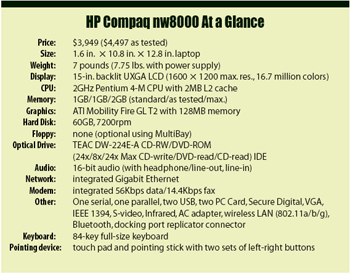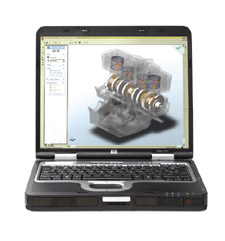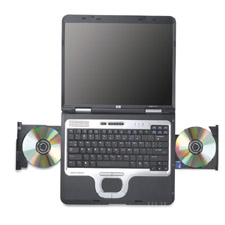Quality and Performance at a Premium Price
HP's Compaq nw8000 might be the best mobile workstation money can buy, but be prepared for the cost.
Latest News
December 4, 2001
By David Cohn
For several years now, laptop computers have been viewed as viable alternatives for engineers and other design professionals on the go. However, most portable systems require some compromise. Hewlett-Packard has recently eliminated the majority of these tradeoffs with the introduction of its Compaq nw8000 mobile workstation. But while this powerful portable packs top-of-the-line components, it also commands a premium price of nearly $4,000.
The nw8000 is based on Intel’s fastest Pentium M 755 CPU (code named Dothan) that runs at 2GHz and features 2MB of L2 cache. The new CPU supports a 400MHz frontside bus and features improved cooling, an enhanced data prefetch system (which makes it more likely that the cache will contain the correct data), and an improved register access manager. HP also includes 1GB of DDR RAM, with room for a second gigabyte of memory.
The Compaq nw8000 mobile workstation is based on Intel’s Pentium M 755 CPU ( 2GHz; 2MB of L2 cache), has a full-size keyboard and includes a CD-RW/DVD-ROM drive. An extra $250 nets an optional DVD+RW drive. | |
Vital Statistics
The dark gray nw8000 weighs just under seven pounds (the power supply and cord add only 12 ounces more) and measures 10.8 inches deep by 12.8 inches wide and 1.6 inches thick, with nicely rounded corners. A single latch button releases the hinged lid to expose a full-size 84-key keyboard. Four buttons located above the function keys control power, a QuickLock feature (which disables the keyboard and pointing device and clears the screen), the built-in wireless network adapter, and a user-configurable presentation mode. Presentation mode lets you open a predefined application, folder, or website; sets the video mode of the external display; and simultaneously displays a presentation on the LCD and external display.
To the right are three LEDs indicating number lock, caps lock, and scroll lock, respectively. There are also five additional LEDs on the front-right edge of the case showing wireless, power, battery charging, hard drive access, and multibay drive access status. Below these are volume controls and a mute button. Built-in pointing devices include both a pointing stick and touch pad, with two sets of left and right buttons. The touch pad can be configured to recognize finger tapping and also allows you to configure four discrete tap zones in the four corners of the pad to activate different commands.
In addition to ample RAM, the nw8000 comes with a 60GB 7,200 rpm hard drive. An ATI Mobility Fire GL T2 graphics processor with 128MB of onboard memory powers a beautiful 15-inch LCD, which can display at up to 1600 3 1200 resolution with 16.7 million colors. You can also extend your Windows desktop onto an external monitor at up to 2048 3 1536 pixels with a refresh rate of up to 200Hz.
ATI’s graphics driver includes PowerPlay, a power management technology that lets you adjust the graphics processor settings for higher performance or longer battery life. The system’s eight-cell lithium-ion battery delivered slightly more than five hours of runtime. An optional second battery ($125) can be added in the modular MultiBay on the right side of the system for an additional 2 1/2 hours of battery life.

Features Aplenty
The nw8000 also packs plenty of expandability and connectivity, with a modem, both wired and wireless LAN adapters, and even Bluetooth. And HP makes no compromises here when it comes to networking. The system’s wired LAN supports 10/100 and Gigabit Ethernet, and the wireless adapter supports all three 802.11 standards (a, b, and g). With two antennas hidden along the edge of the LCD, our wireless signal remained strong even more than 100 feet from the access point. We were also able to connect effortlessly to nearby Bluetooth devices.
On the right side of the case, HP includes two PC Card slots supporting Type I, Type II, or Type III 32-bit (CardBus) or 16-bit PC Cards. There’s also a Secure Digital (SD) slot, an infrared port, the RJ-11 modem jack, audio line-in and headphone/line-out jacks, and the MultiBay, which can accept an optional drive or the aforementioned second battery.
The rear panel provides two USB 2.0 ports, a mini 4-pin IEEE-1394 FireWire connector, 9-pin serial and 25-pin parallel ports, a 15-pin D-sub video connector for an external monitor, an RJ-45 jack for the wired LAN, and an S-video port that can be used to connect to an optional S-video device such as a television, VCR, camcorder, overhead projector, or video capture card. A special connector on the bottom of the computer enables the system to connect to an optional port replicator. There’s also a business card holder on the bottom of the case, a handy addition to help prevent confusion at airport security screenings.
HP also includes a CD-RW/DVD-ROM drive, along with copies of Roxio’s Easy CD Creator and the WinDVD player. But in a system this powerful (and expensive) we would like to have seen a DVD burner. (An optional DVD+RW drive adds $250.) Rounding things out nicely, HP also included a wireless optical mouse ($49) and SpaceTraveler; a 3D input device from 3Dconnexion ($499). But here, the inclusion of just two USB ports (many systems now have three) posed a problem. The wireless mouse uses a small receiver that connects to a USB port. The mouse itself, although wireless, recharges its battery via a separate USB connection. And the SpaceTraveler requires a USB port.

Mouse response proved sluggish at best when used wirelessly. Response improved markedly when connected to the USB charging cable, but that configuration prevented connection of the SpaceTraveler. In addition to that, when recharging, the cable connects to the front of the mouse, directly below your palm, making use of the mouse a bit awkward. Waking the mouse after it goes into its hibernate mode also proved tedious at times.
The 3Dconnexion SpaceTraveler, on the other hand, was an absolute pleasure to use and a very nice addition to the nw8000. This compact device consists of a heavy stainless steel base, measuring 2.5 inches in diameter, topped by a plastic motion controller knob. The heavy base serves to keep the SpaceTraveler firmly anchored on your desk. Eight illuminated programmable buttons surround the base and glow with an attractive blue light. The SpaceTraveler lets you manipulate 3D models in programs such as AutoCAD, Inventor, Solid Edge, and SolidWorks with six degrees of freedom. In applications like Word, Excel, PowerPoint, or Internet Explorer, you can use the SpaceTraveler for horizontal or vertical scrolling, or to zoom in and out of your document. It’s a great addition to any portable system.
Good Looks, Impressive Results
Of course, the real measure of any computer is its performance, and here the nw8000 delivered the most impressive results we’ve seen thus far from any mobile workstation. I loaded and ran several CAD programs as well as various versions of the SPECviewperf and SPECapc benchmarks.
The SPECviewperf results measuring raw graphic performance (in frames per second) were more than double those of the mobile workstations we reviewed previously and approached those of high-powered desktop systems. The results on the SolidWorks SPECapc benchmark was also nearly double those of earlier laptops. Complete results as well as comparisons to several other laptop and desktop systems previously reviewed appear in the accompanying table to the right.
The workstation comes preloaded with Windows XP Professional and is backed by a three-year onsite warranty in the U.S. and Canada. HP has clearly targeted this system directly at the mobile engineering market, with ISV certifications for most MCAD applications. The Compaq nw8000 just might be the best mobile workstation money can buy; just be prepared to spend a considerable amount of money for this level of quality and performance.
David Cohn is a computer consultant and technical writer based in Bellingham, WA. He’s a contributing editor to Desktop Engineering, the publisher and editor-in-chief of Engineering Automation Report, and the author of more than a dozen books including AutoCAD 2002: The Complete Reference, from Osborne/McGraw-Hill. You can contact him via e-mail at Desktop Engineering Feedback.
Company information
Subscribe to our FREE magazine, FREE email newsletters or both!
Latest News
About the Author
David Cohn is a consultant and technical writer based in Bellingham, WA, and has been benchmarking PCs since 1984. He is a Contributing Editor to Digital Engineering, the former senior content manager at 4D Technologies, and the author of more than a dozen books. Email at [email protected] or visit his website at www.dscohn.com.
Follow DE







